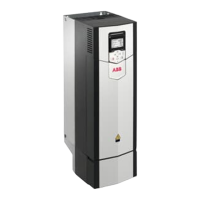Parameter 60.3 defines whether the drive is the master or a follower on the
communication link. Typically, the speed-controlled process master drive is also
configured as the master in the communication.
The communication on the master/follower link is based on the DDCS protocol,
which employs data sets (specifically, data set 41). One data set contains three
16-bit words. The contents of the data set are freely configurable using parameters
61.1…61.3. The data set broadcast by the master typically contains the control
word, speed reference and torque reference, while the followers return a status
word with two actual values.
The default setting of parameter 61.1 is Follower CW. With this setting in the
master, a word consisting of bits 0…11 of 6.1 and four bits selected by parameters
6.45…6.48 is broadcast to the followers. However, bit 3 of the follower control
word is modified so that it remains on as long as the master is modulating, and
its switching to 0 causes the follower to coast to a stop. This is to synchronize the
stopping of both master and follower.
Note: When the master is ramping down to a stop, the follower observes the
decreasing reference but receives no stop command until the master stops
modulating and clears bit 3 of the follower control word. Because of this, the
maximum and minimum speed limits on the follower drive should not have the
same sign – otherwise the follower would be pushing against the limit until the
master finally stops.
Three words of additional data can optionally be read from each follower. The
followers from which data is read are selected by parameter 60.14 in the master.
In each follower drive, the data to be sent is selected by parameters 61.1…61.3.
The data is transferred in integer format over the link, and displayed by parameters
62.28…62.36 in the master. The data can then be forwarded to other parameters
using 62.4…62.12.
To indicate faults in the followers, each follower must be configured to transmit
its status word as one of the above-mentioned data words. In the master, the
corresponding target parameter must be set to Follower SW. The action to be
taken when a follower is faulted is selected by parameter 60.17. External events
(see parameter group 31 Fault functions) can be used to indicate the status of
other bits of the status word.
For block diagrams of the master/follower communication are presented on pages
658 and 659.
Program features 69

